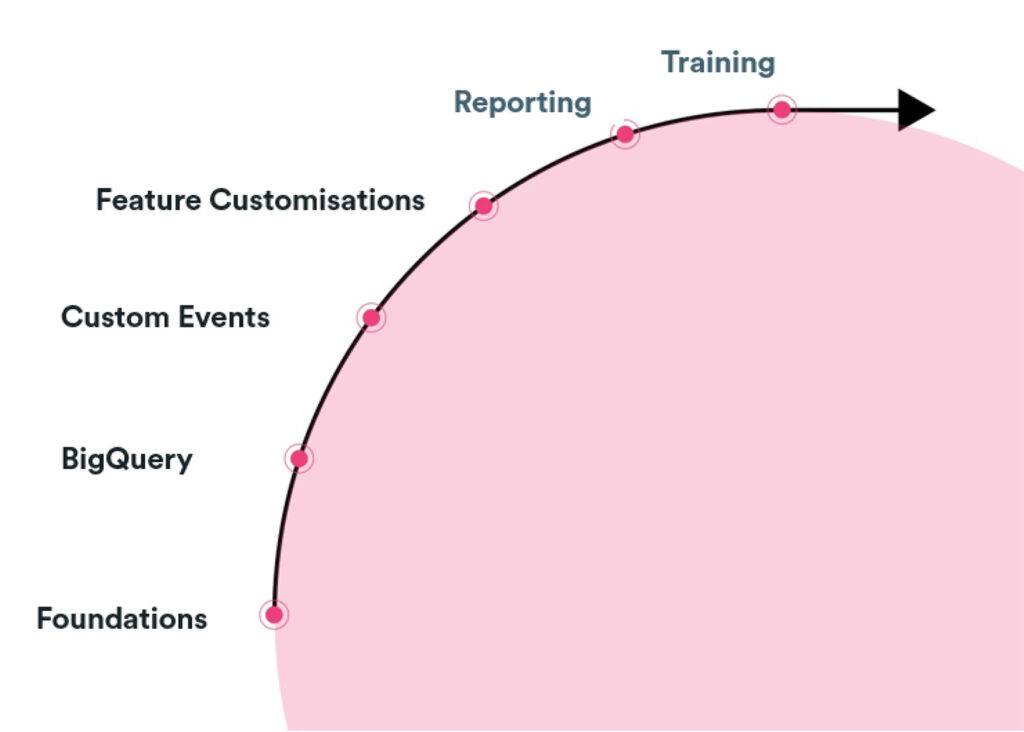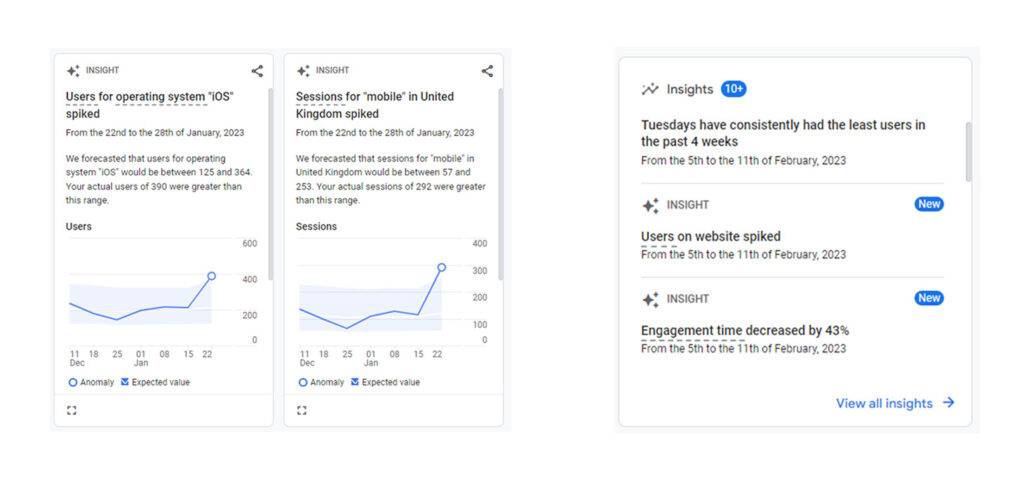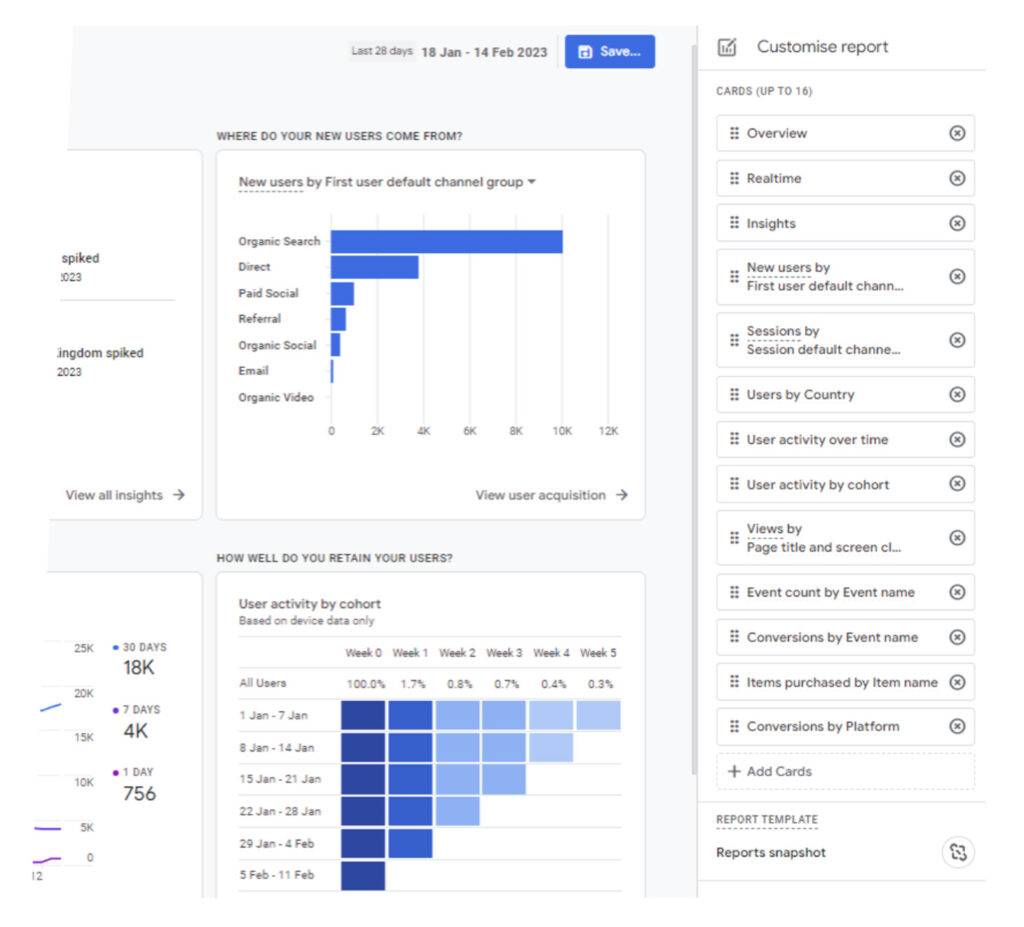What makes GA4 different?
If you are thinking, “why go through all of that difficulty?” Well, GA4 brings with it numerous new and improved capabilities that were previously not available or highly restrictive in nature. With GA4, we see nearly unlimited event collection, allowing you to set up unlimited uniquely named custom events for your web stream, as well as up to 500 custom events for your apps. Within Universal Analytics, event tracking was often restricted due to GA’s hit limit, allowing you to account for only up to 10 million hits per month unless you were a lucky 360 user. Upon crossing the hit limit, your data might not be processed, the speed of your platform would slow down considerably or your data would be heavily sampled.
Data sampling is another significant issue that receives frequent criticism. Only a small percentage of the complete dataset is viewable in the event of data sampling. If you’re a business, running extensive campaigns from time to time and seeing zero users or sessions from your campaigns, it’s not you, it’s simply data sampling . There is no guaranteed access to all of your unsampled data unless you have a 360 account. However, through BigQuery within GA4, you are presented with an alternative to set up data exports to access all your unsampled data as well as have a go at intricate analyses.
Tracking limits have been another major problem in recent years caused by ITP, iOS 13, and cross-device browsing. When users decline the consent to be tracked or move across different devices, you could easily lose view of their engagement behaviour on-site partially or altogether. Furthermore, Legacy user identifiers weren’t very helpful with this. Nonetheless, with the incoming Google signals’ blended data identity system and attribution modelling features within GA4, we could definitely expect an improvement in report accuracy and fewer data gaps than before.
Where is your GA4 today?
If you’ve been following our six-point plan to a successful migration, there are a few steps you would have covered so far. The first one being basic, but definitely the most important one; laying the foundations. This constitutes setting up a GA4 property, its web and app data streams and lastly enabling tracking for these streams. As previously mentioned, you might want to think about using BigQuery for your organisation if you believe you would undoubtedly profit from having access to all your unsampled data.
Otherwise, you could skip straight to the next step of migrating events and custom definitions. While enhanced measurement events are already available to you within GA4, there might be some additional UA events you would want to map across to GA4. When migrating events across, gauge the customs definitions, more specifically the custom dimension or metric for each event. These are created with an aim of providing supporting details to your custom events.
Tailoring your GA4 to your needs is next in line. It is highly based on your settings, so take into account all of them.These include data stream settings, data collection settings or simply linking Google products such as Google Ads or Google Search Console to your property. Once you have completed the above, you are prepared to move on to the final stages of migration.

The last leg of the migration journey
Now, it’s about preparing your teams to make the switch confidently. Sometimes migrating to a new platform is not enough to break those old habits. It’s not easy making the switch overnight. It is a step-by-step process, with an end-goal of establishing reporting and training yourself and your team how to use the platform. This is all done based on data you’ve collected so far and the data you plan to collect in the future.
But there is a lot to learn….
We recommend regular focused training, rather than trying to learn the whole platform at once. So breaking down GA4 into mini sessions where you can learn the dashboard one section at a time is definitely advantageous for you. Laying out a training schedule is the first step, and when doing so, you might want to take these particular factors into account:
- The teams that require training
- The level of technicality they seek
- Their daily usage of GA4.
This would give you information on whether they require an overview session or an in-depth training. Once you have those plans ready, you’re in a good place to start executing the training for your teams. However, if you’re not sure where to start, don’t worry about it. We’re here to help you out. If you need a training plan for your teams or if you need us around to conduct training sessions, just get in touch and we can have something planned out just for you.
Get your reporting ahead of your game…
To prepare yourselves for reporting from the get go, map out the KPIs and dashboards most important to your business. As the name suggests, explore the new flexible custom reporting options available. Previously the ‘Analysis Hub’ within UA, the reporting functionality was limited to 360 users. However, In GA4, the exploration section is available to everyone with numerous analysis and report-sharing capabilities. These enable whole teams to share and benefit from report templates set up by any individual on any team.
In addition to extra chart types, you now have whole new reports and a template gallery to choose from. So get an idea of user engagement behaviour or overall site performance using Free form tables, Path exploration graphs, Segment overlap breakdown and numerous such report types. Unsure where to start but still have a business goal in mind? Simply navigate to the ‘Use cases’ section of the template gallery and pick the reporting bundle most suitable to your business needs. This way, you can produce your very own analytics environment and dive deep into your business insights right away.

AI is your new best friend
Speaking about business insights, AI now detects any unusual change or emerging trend in your data and notifies you immediately on the insight dashboard. Insight dashboards are available on the home page, within individual reports’ sections, and on overview dashboards. Using historical data, AI predicts the value of a metric at a current point in time. If the value falls outside a credible range, it will flag it to you. That way, you will always be aware of the irregularities in your data, enabling you to get insights almost instantly and make business decisions accordingly. Hence, keep on top of your data with AI letting you know if something’s going on.

Plan for tomorrow using today’s data
With reporting requirements laid and insights set out, begin planning for tomorrow using today’s data. It’s all about going beyond what is already available to you. Adding GA4 on your site is a great first step, but it’s not enough to give you an edge. Despite considerable tracking presented at your fingertips with enhanced measurements events within the property, it is not enough. Yes, you obtain the odd insights into user behaviour as they engage with videos, files or site searches, but again, that’s not enough to provide you with more business context.
Ask yourself these questions…
To get some extra help, you need to invest into your GA4 platform. This leaves you with numerous questions and data opportunities as you navigate the platform or utilise reports within the platform. You might notice data points missing from the platform or business specific details yet to be added. If you’re not sure, ask yourself these questions.
- Are we seeing an accurate view of our user behaviour and site performance?
- What are your business goals?
- Are we any closer to achieving these goals based on the data within our GA4?
When you have the answers to all of these questions, you’re ready to start planning for tomorrow. Until then, revisit these areas to ensure you have the data to support these specific aspects of your business. Once ready, you are all set to establish a robust data strategy for your business at present and in the future.
No two businesses are the same, so why should your dashboard be?
Unlike UA offering standardised dashboard views to all, GA4 brings with it the flexibility to prioritise the metrics you care about the most. Data is now presented in summary cards. Along with being visually appealing, summary cards are mobile, giving you the opportunity to move around your reports and structure your overview dashboards to spot key trends at a glance. In addition to AI, summary cards are another quick way to help you derive business insights. To customise your reports snapshot, navigate to the top right corner and click on the little pencil button. Drag and add tabs contingent on your top business or marketing objectives. The best thing is there is a card for everything.

A summary of the Summary cards
Here is a little detail on the cards available to you. To begin with, we have user acquisition, retention, and session cards. These cards explore sources driving users and traffic to your website as well as what value these users bring to your business. Events, conversion, and user engagement cards focus on user engagement, website activity, and conversion by event.
User demographic and tech cards, as the name suggests, go into all the nitty-gritties about the user. So it’s about understanding your audience’s needs based on demographics, which can be their location, their age, their gender, their interest, and the browser and device used to access your website. Last but not least, we have monetisation cards. These are very vital for e-commerce businesses seeking insights into their top selling products or services, top performing ads or other profitability metrics. Hereby, you would be able to make any instant changes as well as scale your revenue as well as your sales.
Only make changes that are meaningful to you
While there are plenty of customisable possibilities within GA4, only implement the changes that are really meaningful to you. The ones that will help you drive your business decisions and devise your marketing strategies. Some convenient changes today could lead to major confusions tomorrow. So, pan out the long-term benefits of your changes to avoid their adversary impact in the long run. And finally, bring everyone on board and keep the relevant teams informed each step of the way when making any amends to your GA4 dashboards.
The few things that will make all the difference….
To summarise everything we have covered so far:
- Your data is only worth what you can do with it. You could have all the data in your GA4 platform but if you don’t know how to use your platform, that data is probably meaningless to you. So, ensure everybody is onboard with training to make the most of the platform and its data.
- Build your very own analytics environment with GA4’s extensive reporting capabilities. Set up custom reports to pick out your KPIs in an instant, without having to spend too much time on the platform.
- AI is your new best friend. It will flag any irregularity in your data, providing quick insights, which could otherwise go unnoticed on a day-to-day basis.
- Plan beyond what GA4 already offers to you. There’s so much more to learn about your business beyond what’s available in GA4. Focus on the additional custom events and custom definitions once you have the basics in place.
- Make your platform truly your own. Your business is unique to you. Let your dashboards reflect your story, users and company. Make meaningful changes and watch the magic happen in your GA4 property.
If you are not sure where to start or finish with your GA4 migration and data set-up, get in touch. You can also see our GA4 support and training offering.
